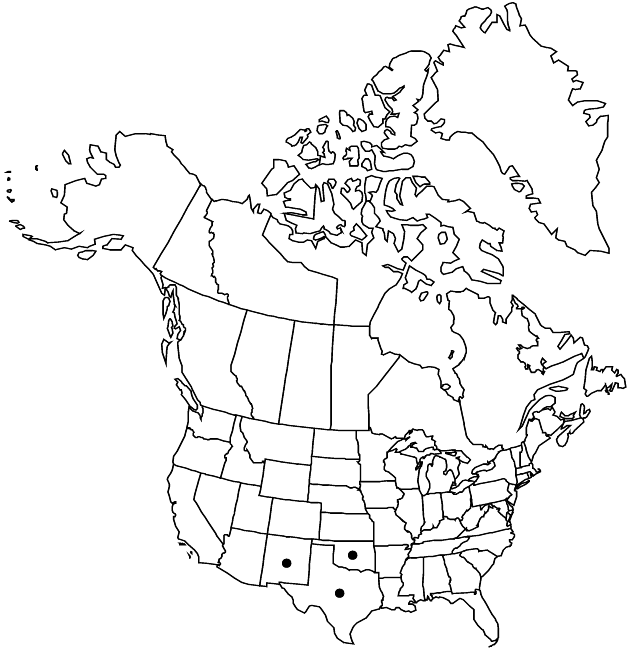Diaperia prolifera var. barnebyi
Novon 14: 470. 2004.
Common names: Barneby rabbit-tobacco
Treatment appears in FNA Volume 19. Treatment on page 463.
Plants silvery white, 3–9 cm, tightly sericeous. Stems mostly 1–5; branches equal to unequal, distal strictly ascending to erect. Leaves: largest 7–11 × 2–3 mm; capitular leaves erect, involucral, proximally carinate, becoming indurate. Heads borne singly, or 2–3 in largest glomerules. Receptacles narrowly conic, 0.9–1.1 mm, heights mostly 2–2.4 times diams. Pistillate paleae: longest 2.5–3.2 mm.
Phenology: Flowering and fruiting mid Apr–mid Jun.
Habitat: Open, dry, shallow rocky or gravelly soils, usually over limestone or gypsum, sometimes with extra moisture (dry drainages, disturbed places)
Elevation: 500–1500 m
Distribution

N.Mex., Okla., Tex.
Discussion
Variety barnebyi is not particularly weedy. It occurs in southwestern Oklahoma, southeastern New Mexico, and western Texas (nearly to Mexico), largely allopatric with var. prolifera.
Selected References
None.
Lower Taxa
None.
... more about "Diaperia prolifera var. barnebyi"
tailed +
introrse +
connate +
plane +
scarious +
hirsute +
papillate +
continuous +
decurrent +
denticulate +
oblanceolate;obovate +
spatulate;oblanceolate;oblong flat +
proximal +
distal +
unequal +
stigmatic +
equal +
barbellulate +
absent +
involucral +
indurate +
Barneby rabbit-tobacco +
actinomorphic +
unequal +
hidden +
glabrous +
monomorphic +
angular +
straight +
obcompressed +
0.9mm;1.2mm +
staminate +
bisexual +
straight +
glabrous +
papillate +
distinct +
staminate +
proximal +
absent +
2;4 +
bisexual +
dispersed +
singly +
Open, dry, shallow rocky or gravelly soils, usually over limestone or gypsum, sometimes with extra moisture (dry drainages, disturbed places) +
singly +
indeterminate +
2-3 times diams +
visible-surpassing +
2;3 +
surrounding +
inconspicuous +
alternate +
equal +
persistent +
2-carpellate +
developed +
inferior +
attached +
anatropous +
pistillate +
imbricate +
longest +
falling +
erect +
surpassing +
bisexual +
persistent +
falling +
absent +
tough +
thick +
connate +
persistent +
distinct +
absent +
equal +
Novon +
2004 +
absent +
2-2.4 times diams +
glabrous +
conic +
fibrous +
exalbuminous +
modifed +
1;3 +
alternate +
2-branched +
glabrous +
papillate +
Diaperia prolifera var. barnebyi +
Diaperia prolifera +
variety +
annual +
silvery white +
sericeous +
staminate +
absent +